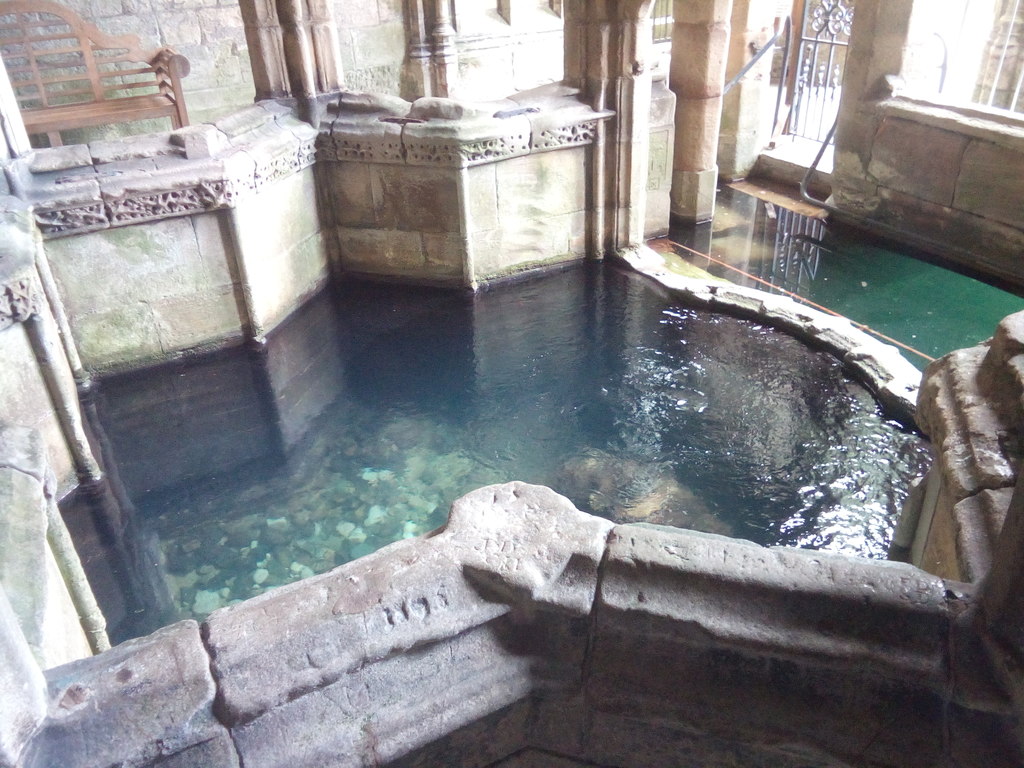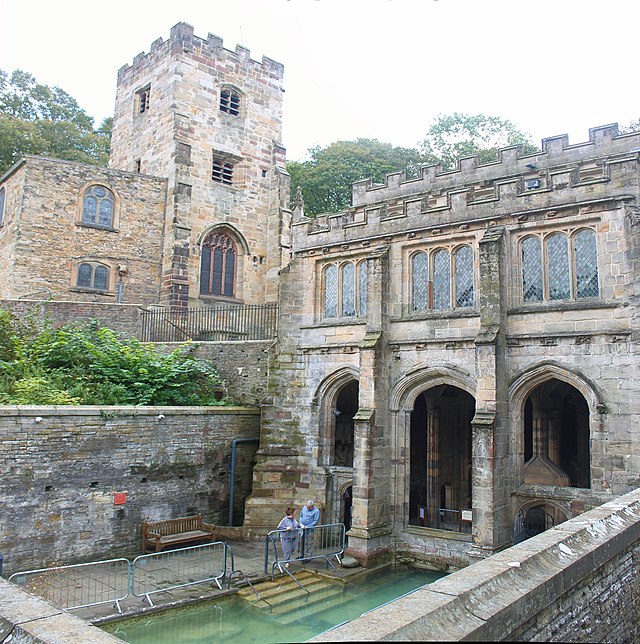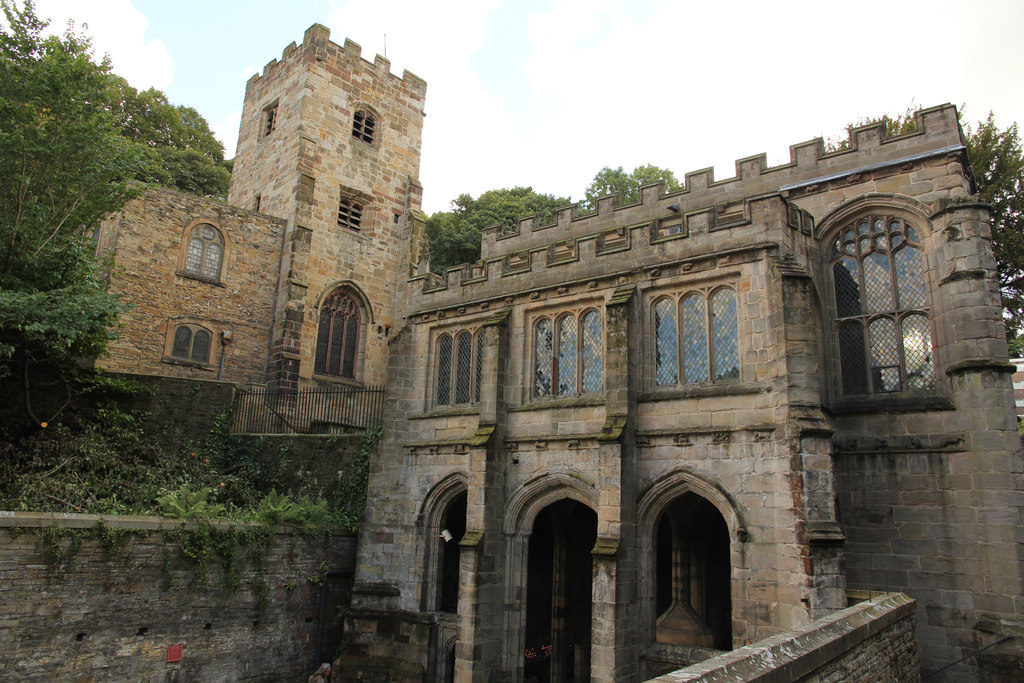
The Well of Saint Winefride, located in the town of Holywell, in Flintshire, Wales, is one of the oldest and most revered Christian pilgrimage sites in the British Isles. Known as the “Lourdes of Wales,” this sacred place has attracted pilgrims for over 13 centuries, seeking spiritual and physical healing in its miraculous waters.
The well is a living testimony of faith and devotion that has endured through the centuries, overcoming political, religious, and social challenges.
Saint Winefride, known for her story of faith, martyrdom, and miracles, is a venerated figure in the Christian tradition. Her legacy has made her sacred well an important destination for any pilgrimage seeker wishing to connect with spirituality and the history of faith.
Saint Winefride, known in Welsh as Gwenffrewi, was born in the 7th century into a noble Welsh family. Her father, Tyfid ap Eiludd, was a local leader, and her mother, Wenlo, was the sister of Saint Beuno, a monk and influential abbot in the region. From an early age, Winefride showed a deep inclination towards religious life, receiving a Christian education and being influenced by her uncle’s teachings.
The most famous legend associated with Saint Winefride tells of her encounter with Prince Caradoc. According to tradition, Caradoc was captivated by Winefride’s beauty and proposed marriage. She, having decided to dedicate herself to religious life and preserve her chastity, rejected his advances. Enraged by the rejection, Caradoc pursued her and, in an act of violence, beheaded her.
At the place where her head fell, a spring of clear water emerged, marking the birth of the sacred well. Saint Beuno, upon learning of his niece’s martyrdom, picked up the head and, through fervent prayers, placed it back on her body, restoring her to life. Caradoc, on the other hand, was divinely punished, according to some versions, being consumed by the earth or struck down.
Saint Winefride was venerated as a saint shortly after her death, and her story spread widely in Wales and beyond.
Although she was never formally canonized by the Roman Catholic Church, her cult was approved and promoted by the Church, especially during the Middle Ages. Her feast day is celebrated on November 3rd, and she is considered the patroness of purity, healing, and curative waters.

The well’s origin is intrinsically linked to the miracle of Winefride’s resurrection. The spring that emerged at the moment of her martyrdom became a symbol of purity and healing. The waters of the well have since been a focus of devotion, with numerous accounts of miraculous healings attributed to her intercession.
The earliest written references to the Well of Saint Winefride date back to the 12th century, in the writings of chroniclers such as Henry of Huntingdon and Giraldus Cambrensis. These accounts describe the well’s fame and the pilgrimages that were already taking place, highlighting its importance in medieval Christianity.
During the Middle Ages, the well became one of the main pilgrimage destinations in Britain. The construction of chapels and structures around the well, as well as support from monarchs and nobles, solidified its status. Kings such as Henry V made pilgrimages to the site, seeking blessings before military campaigns.
The Well of Saint Winefride, with its miraculous origin and connection to faith, has been a symbol of devotion and healing for centuries. Like other sacred sites such as Garabandal, this well attracts believers seeking deep spiritual experiences and the transformative power of faith.
During these centuries, the Well of Saint Winefride reached its peak as a pilgrimage destination. A chapel was built over the well, and pilgrimage routes were established from various parts of England and Wales. The site was enriched with donations and offerings from the faithful, and chronicles from the time record numerous miracles and healings.
The Protestant Reformation in the 16th century posed a significant challenge for the well. Under the reign of Henry VIII, the dissolution of monasteries led to the closure of many Catholic sites. However, despite persecution and prohibitions, popular devotion to Saint Winefride persisted. The well suffered damage and confiscations but remained a clandestine place of worship for Catholics.
With the relaxation of religious restrictions, the well experienced a revival.

The architecture and art of Saint Winefride’s Well reflect centuries of devotion and craftsmanship, making it a unique site in Christian tradition. Unlike the Sanctuary of Guadalupe, this place combines spirituality and architectural beauty, attracting pilgrims seeking inspiration and divine connection.
The chapel of Saint Winefride’s Well is a jewel of Perpendicular Gothic architecture. Built in the late 15th century, it features an elaborate stone vault and fine sculptural details.
The upper chapel is dedicated to worship, while the lower structure houses the well itself, with an immersion pool where pilgrims can bathe in the sacred waters.
Among the remarkable elements are carvings of saints and angels, window tracery, and sculpted pillars. The vaulted ceiling features ribs and decorative bosses, representing religious and heraldic symbols. The chapel’s harmony and elegance reflect the skill of medieval craftsmen and the site’s importance in that era.
The site houses various relics and sacred art objects. Among them are statues of Saint Winefride, stained-glass windows depicting her life and miracles, and votive offerings left by pilgrims over the centuries. These elements enrich the spiritual and cultural experience of the site, connecting the present with its historical past.
Saint Winefride’s Well, with its deep religious significance and tradition of associated miracles, is comparable to sacred places like the Tomb of Mary Magdalene. Both sites stand out as faith destinations where believers seek healing, spiritual inspiration, and a direct connection to the divine.
Since its origins, the well’s waters have been considered miraculous. They are believed to possess healing properties, especially for physical ailments and chronic illnesses. Tradition holds that faith and Saint Winefride’s intercession, along with immersion in the water, can lead to healing.
Numerous testimonies and historical records document cases of people who claimed to have been healed after visiting the well. Medieval chronicles, as well as more recent accounts, tell stories of restored mobility, healing of skin diseases, and relief from mental ailments. These accounts have been crucial in keeping the pilgrimage tradition alive.
Pilgrims often participate in rituals such as immersion in the pool, drinking water from the well, and praying in the chapel. Many undertake novenas and acts of penance, seeking spiritual connection and divine grace. Devotional practices are often personal, but there are also community ceremonies and special masses on significant dates.
This is not only a place of pilgrimage but also a source of inspiration in literature and folklore. Throughout the centuries, its history and mysticism have influenced historical texts, popular traditions, and artistic expressions, enriching the cultural heritage of Wales.
Saint Winefride’s Well has been mentioned in various texts throughout history. Writers such as William Camden and Thomas Pennant included it in their works, highlighting its historical and cultural significance. Victorian literature also reflected interest in the well, with poems and stories exalting its mysticism.
Local legends enrich the well’s history. Stories about apparitions, supernatural events, and orally transmitted tales have kept the tradition alive. These narratives form part of the region’s intangible heritage, reflecting the identity and beliefs of the community.
The well has influenced artistic expressions such as music, painting, and theater in Wales. Works of art depicting Saint Winefride and the well can be found in museums and private collections. Moreover, local festivals and cultural events celebrate its legacy, integrating it into contemporary life.
St. Winefride’s Well, just like the Holy Cities, continues to attract believers and travelers seeking spiritual and cultural experiences. Today, it combines its deep religious significance with activities and services that allow visitors to enjoy this sacred site in a modern and accessible way.
Today, St. Winefride’s Well remains a place of spiritual importance for Christians, especially Catholics. It serves as an ecumenical meeting point, welcoming people from various denominations who seek spiritual renewal and a connection with tradition.
Events such as the annual pilgrimage on the Sunday closest to November 3rd, a date traditionally associated with St. Winefride, take place. These celebrations include processions, special masses, and community activities that strengthen the bonds between the faithful and the local community.
The site is equipped to receive pilgrims and tourists. It features a visitor center offering historical information, a gift shop with religious items, and facilities for people with reduced mobility. Respectful and conscious tourism is encouraged, recognizing the site’s spiritual and cultural value.
It is open every day, allowing pilgrims to visit at any time during the week. Usual hours are from 10 AM to 7 PM, but it is advisable to check specific schedules before your visit, especially on holidays or special event days.
To reach the well, you can use various means of transportation. If traveling by car, the site is well signposted and has nearby parking. Additionally, Holywell has a bus station, from which you can take local transport to the well. If you prefer the train, the nearest station is in Flint, just a few minutes away by taxi from Holywell.
St. Winefride’s Well is not only an important destination on its own but is also connected to other pilgrimage routes in the UK. These routes have been traveled for centuries, linking various places of great spiritual significance. By visiting Holywell, you immerse yourself in a network of historic paths that have been walked by thousands of pilgrims over time.
Besides the well itself, other nearby routes, such as the Camino de Santiago, also pass through the UK, offering a richer and more varied experience for those seeking a journey of faith and reflection.
St. Winefride’s Well is part of the historic North Wales Pilgrim’s Way, one of the most important Christian pilgrimage routes in Wales. This path connects several religious sites, including Holywell, allowing pilgrims to follow in the footsteps of those who traveled centuries ago in search of healing and blessings.
Along this route, you will discover religious monuments, churches, and monasteries, all linked to a rich tradition of faith. The well’s connection to other sacred routes, such as the Camino de Santiago, makes it a key location for those seeking a deep spiritual experience in Wales.
The UK is home to several Christian pilgrimage destinations, all linked to saints and holy events. Glastonbury is famous for its connection to the legend of King Arthur and its church, considered the “Sacred Isle.” Canterbury, with its historic cathedral, is another key destination for pilgrims, as it is the site of Thomas Becket’s martyrdom.
Lindisfarne, known as the Holy Island, houses a medieval monastery that attracts thousands of visitors each year. All these places complement the Christian tradition surrounding St. Winefride’s Well, creating a network of faith destinations throughout the UK.
Local organizations and the Church have worked to preserve the well and its associated structures. Restoration projects have been undertaken to maintain architectural integrity and ensure that future generations can enjoy and learn from the site.
Maintaining the well faces challenges such as erosion, visitor flow management, and the conservation of the natural surroundings. It is crucial to balance public access with the need to protect the site’s historical and environmental heritage.
The local community plays an active role in preserving and promoting the well. Volunteer groups, along with religious authorities, organize events and fundraising campaigns to raise awareness about the site’s importance. This collaboration is essential for ensuring its long-term sustainability.

If you are planning a pilgrimage to St. Winefride’s Well, there are some practical aspects you should consider. From spiritual preparation to travel recommendations, being well-prepared is important.
In the following sections, we provide useful tips to help you make the most of your pilgrimage, from personal preparation to the logistical details of your journey.
If you are coming from abroad, there are some details to keep in mind to facilitate your trip to St. Winefride’s Well.
Its enduring legacy is a testament to the devotion of those who have found in its waters a source of hope and healing. In the context of global Christianity, the well remains a reminder of the power of faith and the importance of preserving our sacred sites for future generations.
Stay Connected with WayHoly
Discover your perfect pilgrimage and be the first to know about new journeys. By subscribing to our newsletter, you’ll receive the latest updates on pilgrimages, exclusive offers, and spiritual resources to enrich your faith journey.
Don’t miss the opportunity to deepen your connection with God and lead others on their path to spiritual renewal. Join us today and become an instrument of His Will through WayHoly!
“To upload your pilgrimage, please choose one of our plans and create an account, or log in if you’re already a member. Join us in guiding others on their spiritual journey.”